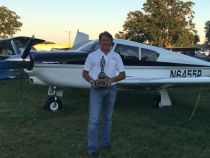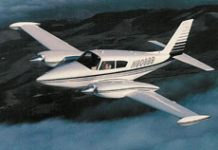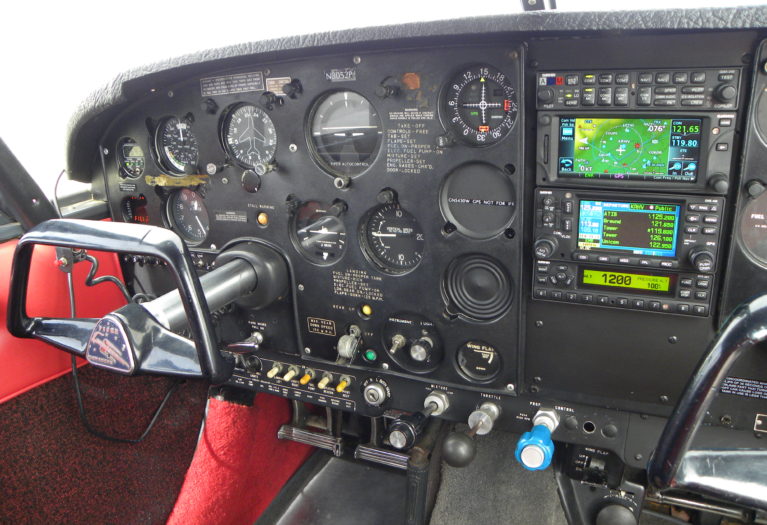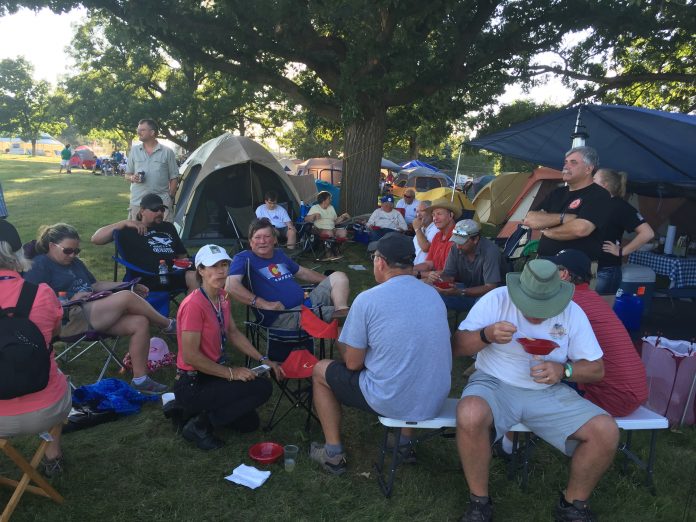Despite rumors to the contrary, the demise of the Comanche aircraft is greatly exaggerated, and the Society is alive and well and growing strong again.
OSH17 was a whirlwind. A record number of new members found the tent, met the crew which included our best technical resources, sat in on the sessions, and joined the society on the spot. Excitingly, these included people returning to the Society after years away. We approach an era where a unified voice can defend our freedom to fly without user fees. Sessions covered everything from emerging panel technologies and how those can give us more layout options, to a current look at the best Comanche mods, to new operating approaches given the new technologies available, to solutions for nervous right seater’s.
” Comancheros Came from all over the world, South America, UK, France, Germany, Australia, New Zealand, Canada, South Africa”

At the famous EAA VAA awards ceremony, including Reserve Grand Champion and Best Continuously Maintained. Comanches won more awards than any other type, including the Silver Lindy (Reserve Grand Champion) won by Lee Hussey II, and Best Continuously Maintained won by Chris Cencula. [Comanches compete in the “Contemporary” (1956-1970) category which includes Beech, Cessna, Mooney, Champion, and of course other Piper]
All this was topped off by a dinner that was very well attended.
We had so many people at Comanche dinner (over 60 all told) that the restaurant literally ran out of tables and chairs. The age range included kids, two Comanche pilots under age 18, a man who has had his plane 37 years, and someone still flying at age 92. It’s clear that for many, their Comanche is almost a family member. values around and get us credibility with shops and vendors, and if this trend continues, we will have new STCs for modern equipment at lower cost, and more Comanche-familiar shops to take our planes to. We had packed audiences in the tent all week. Vendors are starting to recognize that Comanche owners are knowledgeable and very involved in decision making, and because we actually use our airplanes, motivated to learn and buy if the value is there. This fact appears to be attracting the attention of the critical ecosystem of vendors etc required to keep our birds modern, maintained, cost-effectively upgradable, and flying safely. The fact that those vendors and supporters are willing to invest in an aircraft that has not been made since 1972 is a validation of the Comanche value proposition, and is essential to our future. Building a network of suppliers, maintainers, and trainers is the magic formula that will make our Comanches, which easily hold their own against modern $750,000 aircraft in terms of capabilities, easy to own and fly. This network of STCd equipment, trained maintainers, and other supporters provide a competitive advantage against other vintage GA aircraft (which have not created our robust part sourcing network and therefore are at a disadvantage), and support the value proposition built into a bird created with such expertise and care that it remains one of the most efficient and cost effective GA aircraft ever built. This in turn will assure our future and support our hull values.
The people who came by our tent (and I believe all our members), expect that the board and the society are committed to support them and the birds they fly and love. We are in a rising wave of unification and expansion of the society that did not seem possible just 2 years ago. People felt very strongly about the benefit of ICS providing a unified and knowledgeable voice to the various organizations and government agencies that determine how and where we fly and how much it costs. Berl Grant really refined this message and it turned out to be critical. CJ Stumpf was invited to speak at the EAA General Meeting on the utility of the Comanche and similar types as an economic development enabler, particularly for businesses outside of major population centers where there are few major airports. There was a great article in the September issue on this that came out after OSH and it is becoming clear that this is a major initiative that can both benefit the US and International rural economies and benefit our Comanches. There are a growing number of internet-enabled businesses far enough away from a big airport that a Comanche or similar aircraft that can enable the face to face contact required to make business relationships work and businesses grow. Being able to jump into a Comanche at a nearby rural airport and hop over to meet a potential customer, supplier, or vendor levels the playing field for businesses in internet-enabled but remoter regions, and is a key interface point where ICS can provide value to us. Speaking of ICS providing a concentrated voice for its members, it was amazing to have three current and past presidents available (Pat Donovan, Zach Grant, and Bob Cretney), and people loved that they could meet them and found them ready to talk and help. People are also clearly delighted by the access to technical, maintenance, avionics, and training resources that we, ICS, provided at Oshkosh. They were also impressed by the collaboration and transparency involved. A large group looking for a cheap modern autopilot became involved in helping to connect a supportive vendor with the key technical resources needed to move an STC certification process forward, right in front of their eyes. If this STC comes through for the Comanche before it comes through for the Mooney, Beech, or Cessna, and we can get modern three axis autopilots with envelope protection installed for under $15,000, that will be another competitive advantage for the Comanche. We also found two shops and two individuals interested in refurbishing these aircraft and keeping them flying. They call them “projects”. Although the “stock price” (hull value) is depressed due to the fact that the Comanches of many long time owners are going onto the market at the same time in a wave, we also saw at OSH a definite increase in interested buyers, and several pre-buy shops think they are seeing the beginnings of a turnaround in airframe pricing. We were able to make several useful connections at OSH introducing ICS members who were looking for support to those who could provide it. On that note, given that Piper foolishly is not making any more Comanches, we the society need to be proactive in tracking planes that would otherwise be pushed off a cliff, and we need to sponsor a network of “project” enthusiasts that can refurbish them and put them back into service – ideally at a margin to compensate for their time. The equivalent aircraft today sells for over $700,000 for a single and over $1M for a twin. Granted these are new Cirrus’ and Cessna’s, but their mission profile is no better than the Comanche despite an entry price (and insurance cost) that is 10X higher than ours. In fact, one Comanche owner who also has an Aerostar is selling the Aerostar and just got a 400. He didn’t like all the corrosion problems the Aerostar had! Not a problem with our all-zinc-chromated babies! On a similar note, although our display aircraft had signs of having been “rode hard and put away wet”, it also had just flown out from California through all sorts of weather, had never had an annual over $2,000 in 20, and trues at 155 and 15GPH (total combined!) without the turbos, and 180 (and 20 GPH) with them. Furthermore, the most amazing story emerged: at the show, a gentleman and his friend showed up and started walking around the display plane after the tent closed, When I went out to offer help, one asked if I had the history on the plane. Other than that the current owner had owned it for over 20 years, I didn’t have much to offer. He then pointed out to a small eye on the front of the tail and told me it used to go to an attachment point on the right tip tank – it was an HF antenna rig. It turns out he and his father had flown the display aircraft across the Atlantic when he was 14 years old and that the turbo, one of the first installed, had been put in while his father had the plane! He clearly had vivid and fond memories of the trip. What a testimony!
At the show we emphasized the Comanche’s incredibly utility due to a unique combination of fast airspeed for remarkably little gas, roomy cabin, massive useful load, huge range. We also emphasized the almost unique zinc chromating … and as that whole message sank in, you could watch people who had dealt with corrosion problems in other aircraft just light up. We also touched on the incredible strength and efficiency of the laminar flow wing (and the fact that it works especially well when the paint is smooth and not covered with bugs ? , the fact that the CG doesn’t change much over the course of the flight – a key reason the Comanche has such a remarkable useful load, and how much more space the cabin design provides. Speaking of cabin space, one of the few places where the Bonanza and Cessna 182 have an advantage is in headroom, but at OSH we discovered a very cool fact: the Lance and Arrow use the same seat tracks – and their seats go up and down! Go to a boneyard and hey presto, instant headroom! You should redo your weight and balance but given the high useful load, it’s a nice tradeoff if you’re tall.
One key message that emerged that had enormous resonance: other manufacturers such as Cessna have begun boosting the prices of parts for their older fleets with similar price points. Beech is famous for expensive parts. Unlike the rest of the older fleet with our mission profile, we are incredibly self sufficient. We have been sourcing our own parts since 1972 so we are not subject to this problem. Other investors in other aircraft with a similar price entry, are looking sadly at the uncertain future of orphaned aircraft, but not us Comancheros!
This, and plus the incredibly strong performance as against beech, Cessna, Mooney, Cirrus, and other Pipers, is a message that resonates. Add the predictable maintenance costs and lower insurance rates commensurate with the lower entry costs and, well….Why Fly Anything Else ?
It also became clear that sessions next year on successful partnerships, and believe it or not on paint, will be well received. I counted 5 successful partnerships and 2 problem partnerships, so we will have a panel on Ways to Put Together Great Partnerships.
A final note for those of you who like fly-ins: as Northeast Tribe Chief, I showed a lot of comancheros our online fly-in schedule and registration form (thanks to our scribe/webmaster Pete Morse and fly-in coordinators Ron and Lynn Ward). There was enough positive feedback that President Pat Donovan has made plans to expand this approach as well as the new FlyShare program. More on that in future issues, watch this space!
Come see us next year at OSH18!











